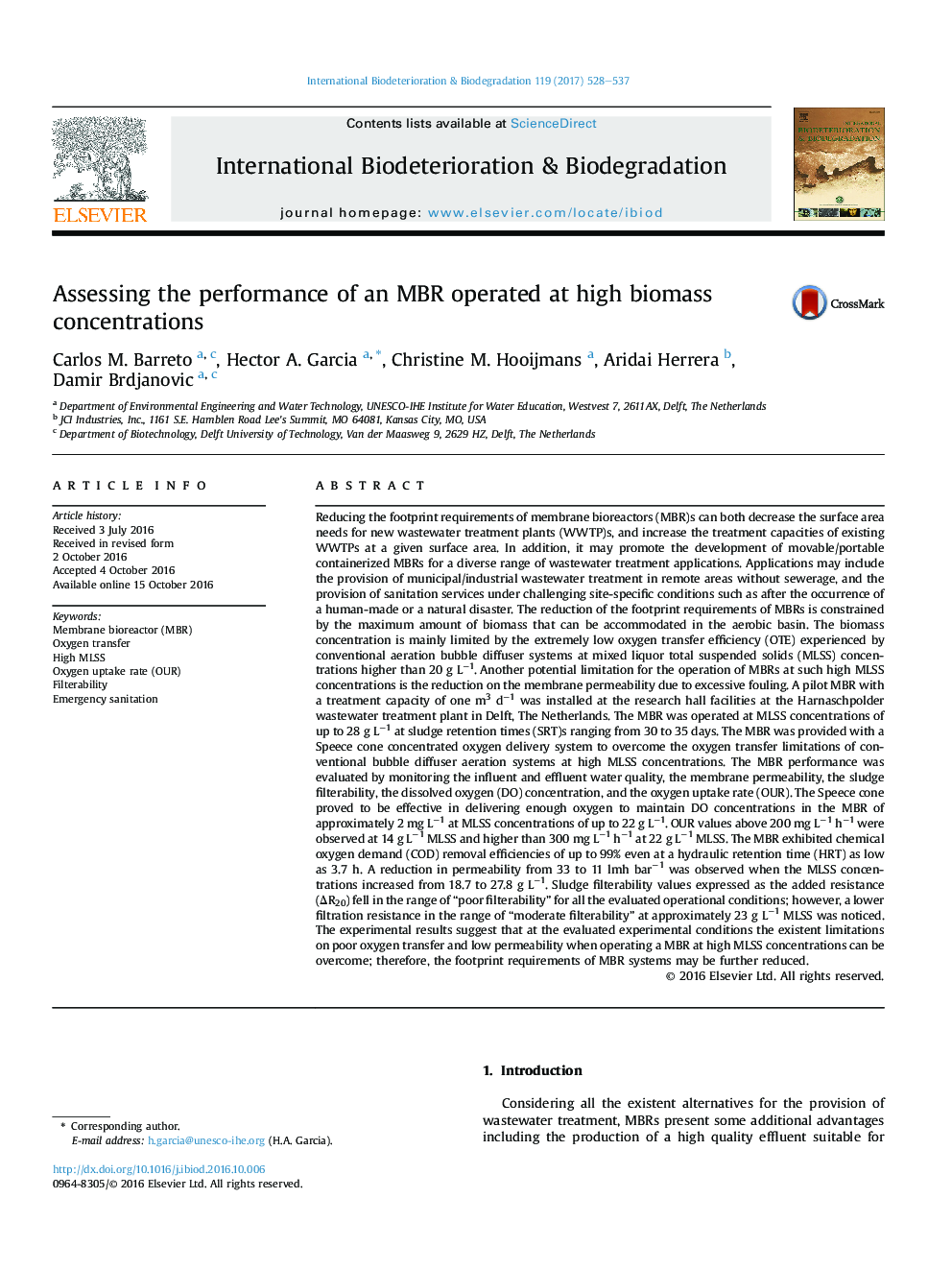| کد مقاله | کد نشریه | سال انتشار | مقاله انگلیسی | نسخه تمام متن |
|---|---|---|---|---|
| 5740480 | 1616298 | 2017 | 10 صفحه PDF | دانلود رایگان |

- MBR footprint requirements can be reduced by operating MBRs at high MLSS concentrations.
- Oxygen transfer limitations observed by conventional diffusers at high MLSS can be overcome by using the Speece cone system.
- The design of high MLSS MBRs promotes the development of alternative sanitation including portable and decentralized systems.
- The maximum OUR measured at 22 g Lâ1 was higher than 300 mg O2 Lâ1 hâ1.
Reducing the footprint requirements of membrane bioreactors (MBR)s can both decrease the surface area needs for new wastewater treatment plants (WWTP)s, and increase the treatment capacities of existing WWTPs at a given surface area. In addition, it may promote the development of movable/portable containerized MBRs for a diverse range of wastewater treatment applications. Applications may include the provision of municipal/industrial wastewater treatment in remote areas without sewerage, and the provision of sanitation services under challenging site-specific conditions such as after the occurrence of a human-made or a natural disaster. The reduction of the footprint requirements of MBRs is constrained by the maximum amount of biomass that can be accommodated in the aerobic basin. The biomass concentration is mainly limited by the extremely low oxygen transfer efficiency (OTE) experienced by conventional aeration bubble diffuser systems at mixed liquor total suspended solids (MLSS) concentrations higher than 20 g Lâ1. Another potential limitation for the operation of MBRs at such high MLSS concentrations is the reduction on the membrane permeability due to excessive fouling. A pilot MBR with a treatment capacity of one m3 dâ1 was installed at the research hall facilities at the Harnaschpolder wastewater treatment plant in Delft, The Netherlands. The MBR was operated at MLSS concentrations of up to 28 g Lâ1 at sludge retention times (SRT)s ranging from 30 to 35 days. The MBR was provided with a Speece cone concentrated oxygen delivery system to overcome the oxygen transfer limitations of conventional bubble diffuser aeration systems at high MLSS concentrations. The MBR performance was evaluated by monitoring the influent and effluent water quality, the membrane permeability, the sludge filterability, the dissolved oxygen (DO) concentration, and the oxygen uptake rate (OUR). The Speece cone proved to be effective in delivering enough oxygen to maintain DO concentrations in the MBR of approximately 2 mg Lâ1 at MLSS concentrations of up to 22 g Lâ1. OUR values above 200 mg Lâ1 hâ1 were observed at 14 g Lâ1 MLSS and higher than 300 mg Lâ1 hâ1 at 22 g Lâ1 MLSS. The MBR exhibited chemical oxygen demand (COD) removal efficiencies of up to 99% even at a hydraulic retention time (HRT) as low as 3.7 h. A reduction in permeability from 33 to 11 lmh barâ1 was observed when the MLSS concentrations increased from 18.7 to 27.8 g Lâ1. Sludge filterability values expressed as the added resistance (ÎR20) fell in the range of “poor filterability” for all the evaluated operational conditions; however, a lower filtration resistance in the range of “moderate filterability” at approximately 23 g Lâ1 MLSS was noticed. The experimental results suggest that at the evaluated experimental conditions the existent limitations on poor oxygen transfer and low permeability when operating a MBR at high MLSS concentrations can be overcome; therefore, the footprint requirements of MBR systems may be further reduced.
238
Journal: International Biodeterioration & Biodegradation - Volume 119, April 2017, Pages 528-537